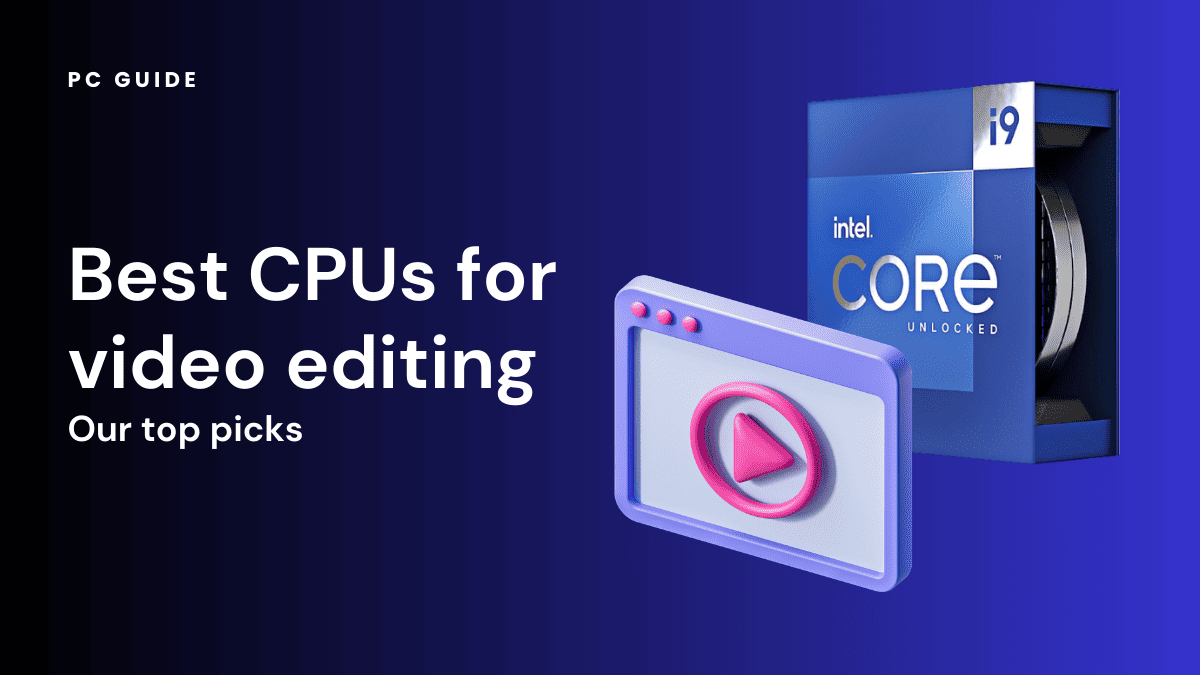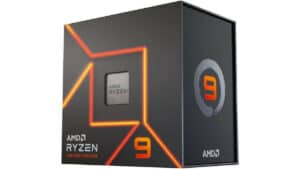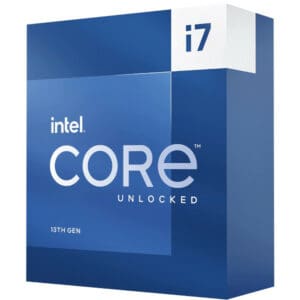Best CPUs for video editing in 2024 – Intel, AMD and budget picks

In this article, we will explore the best CPUs for video editing, comparing their performance, specifications, and price to help you make an informed decision. Whether you’re a professional video editor or a hobbyist, finding the right CPU can make a significant difference in your workflow and the quality of your finished projects.
Video editing is a demanding task that requires a powerful CPU to handle high-resolution footage and complex editing software.
With so many options on the market, it can be overwhelming to choose the right CPU for your video editing needs.
Products at a Glance
How we picked the best CPUs for video editing
When selecting the best CPUs for video editing, we looked at the number of cores and threads each CPU had, as this determines the level of multitasking and simultaneous processing that the CPU can handle. A higher number of cores and threads allow for faster rendering times, smoother editing, and better performance when using multiple applications.
We also considered the clock speed, which determines how quickly the CPU can execute tasks. A high clock speed is essential for faster rendering and exporting times.
Another important factor we looked at was the cache size, which is the memory available to the CPU to store frequently accessed data. A larger cache size can lead to better performance in tasks that require frequent data access.
In addition to these technical specifications, we also considered the overall value for money and user reviews. We only included CPUs that offered excellent performance at their price points and that had consistently positive feedback from users.
After considering all these factors, we were able to select the best CPUs for video editing that offer powerful performance, fast processing times, and optimal multitasking capabilities.
If you are looking for more CPU recommendations, then head over to our best budget CPUs guide. As well as, our best CPU for gaming article.
Product Reviews
- Great single-core and multi-core performance
- PCIe 5.0 support
- Great for 4K video editing
- DDR5 and AM5 needed
The Ryzen 9 7950X is an exceptional CPU for video editing, offering a perfect balance between high-end performance and a reasonable price point. Its superior core count, combined with the Zen 4 architecture, makes it an ideal choice for video editing tasks. We’ve handpicked this CPU as the best choice for video editing because of its overall power and versatility. Regardless of the resolution or complexity of your project, the Ryzen 9 7950X can handle it with ease.
The CPU’s impressive specifications, including 16 cores and 32 threads, a TSMC 5nm lithography, and Zen 4 architecture, make it an excellent option for handling complex image and video editing tasks. Additionally, its massive 64 MB L3 cache allows for speedy data access, enhancing processing speed and overall performance.
The Ryzen 9 7950X boasts a base frequency of 4.5 GHz and a boost frequency of 5.7 GHz, making it a fast and efficient processor. However, it comes with a TDP of 170 W, which may cause it to generate more heat than other CPUs, necessitating a more powerful cooling system.
Overall, the Ryzen 9 7950X is the best processor for professional editors who require exceptional performance and reliability from their systems. Its high core count, Zen 4 architecture, and impressive specifications make it a top choice for video editing tasks.
- High amount of cores
- Hybrid architecture
- Large 36MB L3 cache
- High price point
- High TDP of 125W
- May be overkill for users who don't require such high processing power
Intel’s Core i9-13900K is a top-tier CPU that delivers exceptional performance for video editing. Its hybrid architecture, consisting of 8 P-Cores and 16 E-Cores, allows for outstanding multi-threaded performance, making it perfect for complex image and video editing tasks. This CPU is also backward compatible, meaning it can be used with older motherboards and DDR4 RAM options.
With Intel’s 13th-generation technology and 10nm lithography, the i9-13900K boasts an impressive 24 cores and 32 threads, making it a powerhouse for handling even the most demanding video editing tasks. The CPU has a base frequency of 3 GHz and a boost clock speed of 5.8 GHz, providing lightning-fast processing speeds. Its large 36 MB L3 cache size also helps to quickly access frequently used data, which improves processing times.
However, the i9-13900K has a TDP of 125 W, which means it may generate more heat than other chipsets, requiring a more robust cooling system. Nevertheless, it remains one of the best options for professional video editors seeking top-tier performance.
- Good value for its price range
- Excellent multi-threaded performance
- Supports overclocking
- Lower base clock speed
- Higher TDP compared to some other budget CPUs.
The Intel Core i5-13600K is the ideal option for users who are looking for an affordable CPU that doesn’t compromise on performance. With its 14 cores and 20 threads, this CPU delivers outstanding multi-threaded performance that is perfect for production workloads such as video editing. The Core i5-13600K’s boost clock of up to 5.1GHz makes it more than capable of handling single-threaded tasks with ease, which is a bonus for video editors who don’t want to break the bank.
One of the best things about the Core i5-13600K is its excellent value proposition. It offers performance that is comparable to more expensive CPUs, making it an excellent mid-range option for users who want to save some money. Additionally, the Core i5-13600K supports overclocking, meaning that users can push it even further and get even more performance out of it.
Regarding power consumption, the Core i5-13600K has a TDP of 125W, which is relatively low for a CPU with this level of performance. However, it is worth noting that the TDP can increase to 181W when the CPU is in boost mode, so users should ensure that their cooling solution can handle this extra power draw.
When it comes to content creation, the Core i5-13600K delivers excellent performance that is comparable to more expensive processors. In fact, it outperforms the previous generation’s Core i7 in some tests, making it an excellent choice for budget-conscious video editors who want to get the most out of their creative setups.
Overall, the Intel Core i5-13600K is an outstanding budget CPU that offers exceptional performance, making it a fantastic option for users who want to save money without sacrificing performance. It is perfect for productivity workloads, video editing, and even overclocking, making it one of the most versatile CPUs in its price range.
- Good balance of clock speed and cache size
- Energy efficient with a 125W TDP
- Limited overclocking potential
A high-performance CPU is essential for any video editing tasks, and the Intel Core i7-13700K is an excellent mid-range option that provides a good balance between price and performance. Priced at $409, this CPU offers eight Performance-cores and eight Efficient-cores, giving it a total of 16 cores, as well as Intel’s Hyper-Threading technology, which enables it to process up to 24 threads simultaneously.
With a maximum P-core turbo frequency of 5.30GHz and a maximum E-core turbo frequency of 4.20GHz, the Core i7-13700K can handle demanding tasks with ease, making it a great choice for video editing. Additionally, when paired with a high-performance GPU like the RTX 4080, this CPU can deliver exceptional performance without breaking the bank.
The i7-13700K also has a relatively low TDP of 125W, which means that it doesn’t consume too much power and produces less heat compared to other CPUs with similar performance. This makes it easier to manage the CPU’s thermals and potentially reduces the need for a more powerful cooling solution.
Overall, the Intel Core i7-13700K is an excellent mid-range CPU for video editing, offering a good balance between price and performance. Its combination of core count, clock speeds, and Hyper-Threading technology make it a powerful CPU that can handle demanding tasks with ease.
- Great value for money
- Good multi-tasking performance
- No integrated graphics
Finally, on our list of the top CPUs for video editing, we have the AMD Ryzen 7 3700X CPU. The Ryzen 7 series is known to be a great mid-range option for many users thanks to its performance.
With this CPU you’ll get 8 cores and 16 threads, as well as 36 MB of cache, despite its mid-range price tag. This previous generation CPU from AMD still has a decent base clock speed of 3.6 GHz and a boost clock speed of 4.4 GHz. It is also a highly efficient 65-watt TDP processor that uses the AMD AM4 socket, making it compatible with a wide range of motherboards.
If you’re looking for a value-for-money option from AMD, you can’t go wrong with the Ryzen 7 3700X processor.
Features and considerations
A CPU with a higher core count and clock speed will generally provide better performance for video editing tasks. Additionally, having more RAM and a dedicated graphics card can also improve your editing experience. Ultimately, it’s important to consider your specific needs and budget when selecting a CPU for video editing.
To edit in large resolution such as 4K, you will need a CPU with at least 12 cores and a clock speed of at least 3.7 GHz. However, the more cores and higher clock speeds you have, the better your editing performance will be, especially when dealing with complex video projects or high-resolution footage. Additionally, having a dedicated graphics card can also greatly enhance your video editing workflow.
Aside from the number of cores, there are several other features that are important for a CPU for video editing. These include the clock speed, cache size, and support for hyper-threading. A higher clock speed means that the CPU can process data faster, which is important for editing large video files. A larger cache size allows the CPU to store more data close to the processor, reducing the need to access slower RAM. Hyper-threading is also beneficial, as it allows the CPU to handle more threads simultaneously, improving overall performance. Additionally, support for hardware encoding and decoding, such as Intel Quick Sync, can significantly speed up video rendering times.
Our Verdict
The four CPUs mentioned above offer great options for the task, each with its unique strengths, depending on your specific requirements and budget. The Intel Core i9-13900K is the top-of-the-line choice, boasting 24 cores and 32 threads, making it perfect for demanding tasks such as 3D rendering or video editing. The AMD Ryzen 9 7950X is also a robust option, with 16 cores and 32 threads, along with an impressive 64MB L3 cache for quick data access.
For those with a tighter budget, the Intel Core i5-13600K and Intel Core i7-13700K are excellent mid-range choices. Although they have fewer cores than the i9 and Ryzen 9, they still offer impressive clock speeds and cache sizes, making them suitable for most content creation tasks.
When selecting a CPU for Photoshop, important factors to consider include clock speed, core count, cache size, processor architecture, TDP, and overclocking capability. Additionally, it’s crucial to balance your needs with your available funds. Overall, any of the above CPUs would be a wise investment for professionals or enthusiasts looking to enhance their Photoshop experience.
Having a powerful CPU is essential for video editing tasks, and Intel offers a range of CPUs that are well-suited for this purpose. The Intel Core i9-13900K is the best CPU for video editing, with its 24 cores and 32 threads, making it ideal for handling even the most demanding image editing tasks. The Intel Core i5-13600K is an excellent budget option that delivers exceptional performance, making it a great choice for those who want to save money without sacrificing performance.
Finally, the Intel Core i7-13700K is the perfect mid-range CPU for video editing, offering an excellent balance of price and performance. Whether you’re a professional or a hobbyist, these CPUs provide the power and versatility needed to create high-quality video content.







